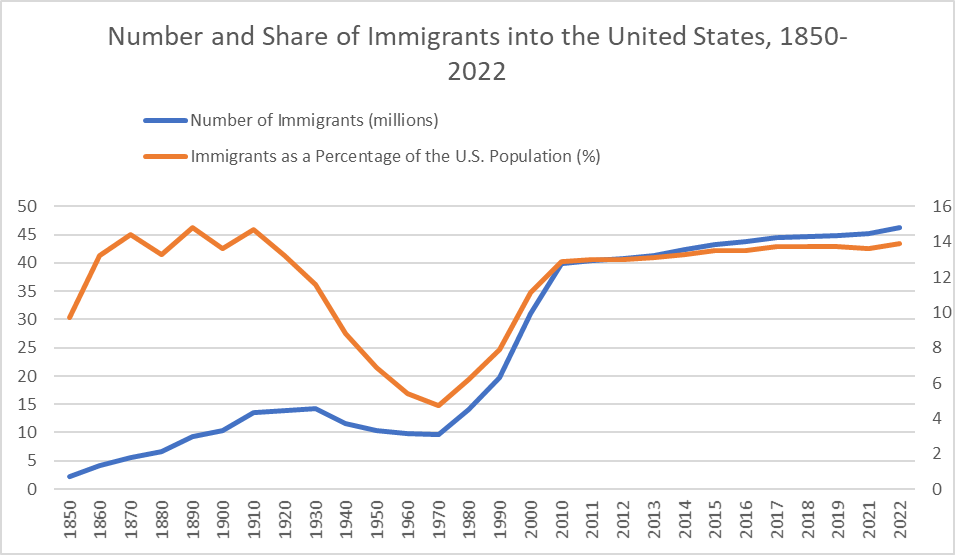Rhetoric vs. Reality: The Political Manipulation of Immigration Issues | The Urban Lens Newsletter
Throughout history, waves of immigrants have arrived on American shores, drawn by the promise of opportunity and freedom. This steady influx has profoundly shaped the United States, transforming it from a primarily agrarian, rural nation into today’s diverse and economically vibrant country. The influence of immigration is evident primarily in the nation's bustling, innovative urban areas, driven by the availability of jobs, existing immigrant communities, and access to essential resources and services.

Throughout history, waves of immigrants have arrived on American shores, drawn by the promise of opportunity and freedom. This steady influx has profoundly shaped the United States, transforming it from a primarily agrarian, rural nation into today’s diverse and economically vibrant country. The influence of immigration is evident primarily in the nation's bustling, innovative urban areas, driven by the availability of jobs, existing immigrant communities, and access to essential resources and services.
However, the 2024 Republican Party platform emphasizes strengthening border security and tightening immigration policies. It describes immigrants as "Christian-hating Communists, Marxists, and Socialists," and "jihadists and jihadist sympathizers," and vows to halt their entry. Despite the U.S. being a nation of immigrants, this sort of anti-immigrant rhetoric is prominent in national politics. This raises the question: do data and analysis support these views?
According to estimates from the Pew Research Center and the United Nations International Migration Report (2020), around 51 million migrants currently live in the United States. The Migration Policy Institute estimates about 45 million, suggesting that approximately 14% of the national population are immigrants. Additionally, the U.S. Census Bureau’s Population Clock indicates that the U.S. gains one international (net) immigrant every 28 seconds, adding approximately 1,126,286 people to the population each year. This means immigration contributes roughly 0.33% to the total population annually, suggesting that immigrants as a share of the total population will remain stable or grow somewhat over time.
Future trends in immigrant population size and integration depend on birth rates, economic opportunities, and immigration policies. Given that public policy directly impacts these factors and influences economic growth and social stability, the current political focus on migration policy is justified by both economic and demographic data.
The Migration Policy Institute and U.S. Census Bureau data shown in the following graphic infers that political claims about the current numbers of migrants being the largest ever in American history are accurate, at least in terms of absolute numbers. However, these claims tend to overlook the fact that today's U.S. population is much larger than ever before. For example, an influx of 1 million immigrants has a vastly different effect on a country with 10 million people compared to one with 100 million.
The more meaningful comparison for public policy is the share of immigrants relative to the total population. Today’s approximately 14% immigration share is above the historical average of about 12% since 1850, but not unprecedented; the highest share was 14.2% from 1870 to 1910.

Source: Migration Policy Institute (MPI) tabulation of data from U.S. Census Bureau, 2010, 2015, 2019, 2021, and 2022 American Community Surveys (ACS), and 1970, 1990, and 2000 Decennial Census.
Accordingly, the late 19th and early 20th centuries saw significant population growth in cities like New York, Chicago, Cleveland, Pittsburgh, and San Francisco due to large numbers of immigrants seeking job opportunities. This led to economic growth, rapid urbanization, and the embedding of a dynamic multicultural landscape into the social and economic fabric of these cities. Even today, immigrants are crucial to maintaining robust growth in the U.S.; without them, growth would be significantly stunted.
A 2017 National Academy of Sciences report, “The Economic and Fiscal Consequences of Migration,” highlighted that immigration supplies workers, boosts innovation, and contributes to long-term economic growth. The report stated, “The prospects for long-run economic growth in the United States would be considerably dimmed without the contributions of high-skilled immigrants.” In addition, as U.S. workers’ education levels continue to rise and the gap between labor demand and the skills of U.S. workers continues to widen, immigrants can contribute to the fulfillment of demand for lower-skill jobs in health care, hospitality, and other fields.
Historically, immigration also led to intergroup conflicts. For instance, particularly intense conflicts over jobs and housing occurred during the peak immigration years toward the end of the 1870s and 1880s in San Francisco. Starting at about the same time and lasting through the 1920s, similar tensions arose in New York, with riots and violent conflicts between large influxes of Irish, Italian, and Jewish immigrants. These conflicts, driven by cultural differences and competition for jobs and housing, in many respects mirror current immigration-related tensions.
More recent examples of hostility toward immigrants include the El Paso Walmart Shooting on August 3, 2019, in which a white male killed 23 people, mostly Hispanic, citing anti-immigrant and anti-Hispanic sentiments in a manifesto he posted online before the attack. Anti-Asian prejudice during the COVID-19 pandemic led to physical assaults, verbal harassment, stabbings, and other violent acts.
Today's immigrants come from more diverse regions, likely continuing to shape the multicultural environment of American urban areas and potentially bringing conflict. National as well as urban policymakers must address these challenges through integration programs, housing policies, and ensuring educational and healthcare systems can accommodate growing and diverse populations. Effective policies should expand infrastructure, facilitate assimilation, harness the economic potential of a larger labor force, and mitigate potential conflicts.
Turning to the political rhetoric that associates immigrants and crime, research indicates that immigrants have lower crime rates than native-born Americans. A 2018 Cato Institute study found that undocumented immigrants have a 47% lower incarceration rate than native-born Americans. The Public Policy Institute of California reported that immigrants are far less likely to commit crimes. A National Academy of Sciences report in 2015 and longitudinal studies, like those by sociologist Robert Sampson, support these findings. Policies should reflect this understanding, promoting integration and countering unfounded fears and stereotypes.
Despite numerous statistics showing that crime rates among immigrants are not higher than, and quite possibly lower than, among native-born Americans, some social media sites and certain "news" outlets amplify and exaggerate isolated incidents to manipulate public opinion. This selective reporting distorts the overall narrative, fostering unwarranted fear and prejudice.
However, some crimes committed by immigrants are serious. Policymakers should adopt comprehensive strategies to improve border security and law enforcement to address crime while supporting integration and leveraging immigrants' positive contributions. These strategies could include advanced technology and intelligence-sharing to intercept criminal activities and expedite legal immigration processes.
A subsequent newsletter will consider the issue of unauthorized immigration. In 2021, the Migration Policy Institute estimated that around 24% of the U.S. immigrant population was unauthorized. This figure is consistent with data from other sources, indicating that a substantial minority of immigrants are unauthorized.
On balance, the current opportunities and challenges of immigration, while notable, have historical precedents. Available data and research suggest that while some aspects of immigration bring real problems and challenges, others are rhetorically manufactured or taken out of context for political manipulation. Partisan rhetoric on immigration often emphasizes problems over data, with the current Republican platform misleading and dividing people while also overlooking the tremendously positive historical and economic contributions of immigrants.
Recognizing both the benefits and challenges of immigration, and doing so based on data and impartial analysis, is vital for formulating policies that serve the long-term interests of current and future generations of Americans. By harnessing the potential of a larger labor force and cultural diversity, American urban, suburban, and rural areas can all achieve better prospects for long-term prosperity.
Bill Bowen
Source: Substack
 Printer-friendly version
Printer-friendly version- Login to post comments







